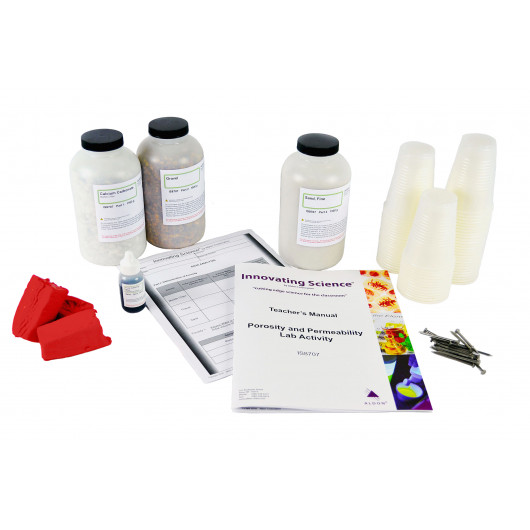

Porosity and Permeability Lab Activity
In this activity, students will examine three different substrates and determine the porosity of each.
While sources of fresh water are usually associated with visible bodies of water such as lakes, rivers, ponds, and streams, the majority of fresh water on Earth is actually underground, collectively referred to as groundwater. Like fresh water found on the surface, groundwater can flow beneath the surface of the planet. Porosity and permeability are two factors that affect both how much groundwater may be found in a given area and the ability of this water to move beneath the surface as well as affect the degree in which certain environmental issues, such as water pollution, may impact different areas. After finding the volume of water each substrate can hold, students will then compare the permeability of the different substrates in order to determine how each may affect the ability of water to move beneath the surface. Kit contains enough materials for 15 groups. Teacher’s Manual and Student Study Guide copymasters are included.
Aligned to the Next Generation Science Standards (NGSS)*
Disciplinary Core Ideas: ESS3.A; ESS2.A
Performance Expectations: MS- ESS3-1; HS-ESS2-2; HS- ESS3-1
Cross Cutting Concepts: Influence of Science, Engineering and Technology on Society and the Natural World; Stability and Change; Cause and Effect
Engineering Practices: Constructing Explanations and Designing Solutions; Developing and Using Models
Kit Includes:
- Marble chips
- Medium gravel
- Coarse sand
- 60 Plastic cups
- 15 Nails
- Modeling clay
- 25mL Food coloring
Regulatory Note: Non Regulated
*”Next Generation Science Standards” is a registered trademark of Achieve. Neither Achieve nor the lead states and partners that developed the Next Generation Science Standards was involved in the production of, and does not endorse, this product.
![]() WARNING: This product can expose you to chemicals including Respirable crystalline silica, which is known to the State of California to cause cancer. For more information go to www.P65Warnings.ca.gov.
WARNING: This product can expose you to chemicals including Respirable crystalline silica, which is known to the State of California to cause cancer. For more information go to www.P65Warnings.ca.gov.

